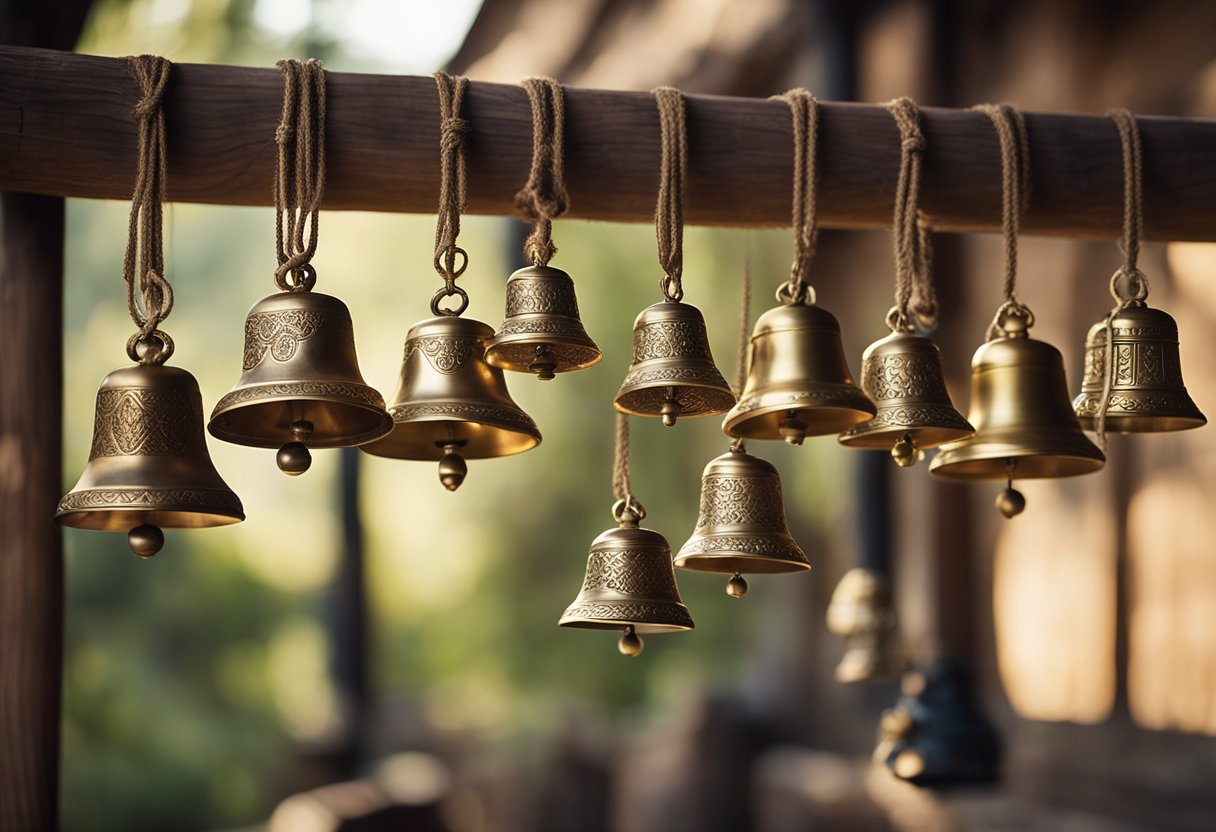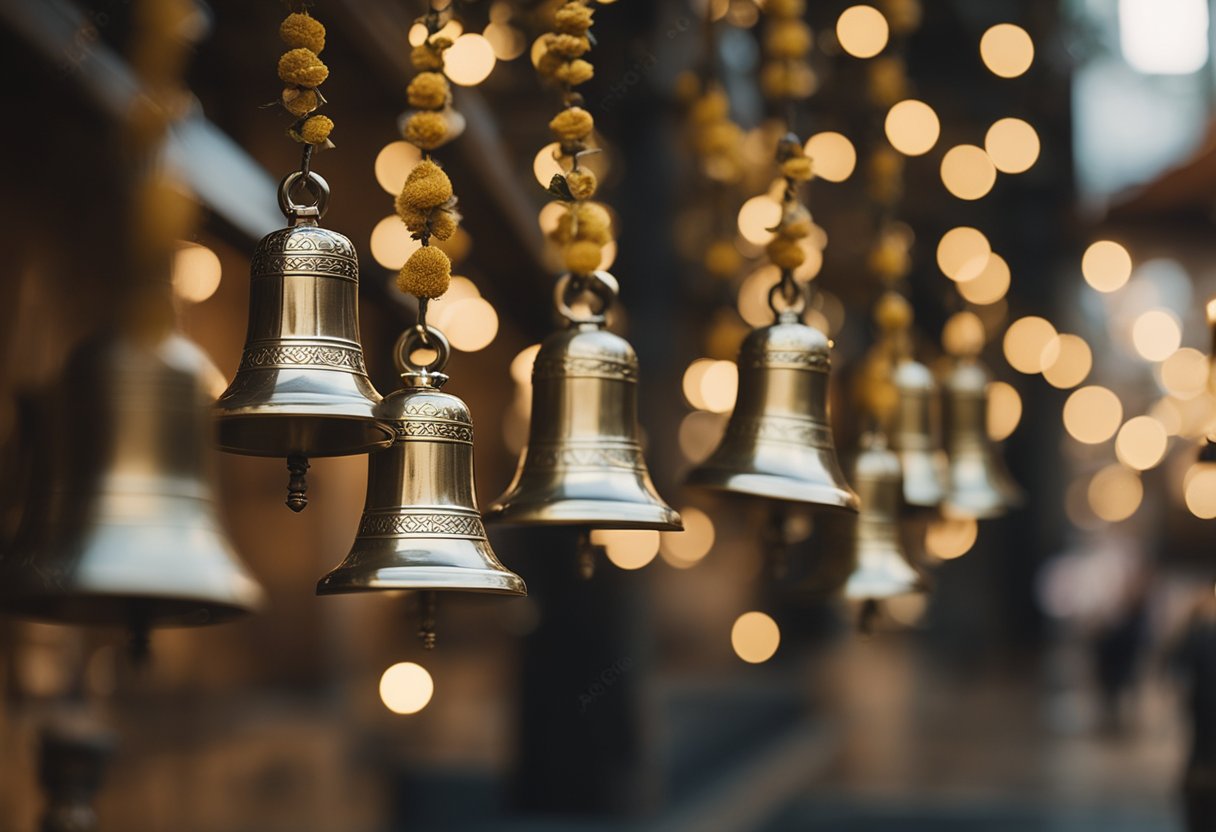The Role of Bells in Cultures Around the World: Significance in Religious Practices and Festivities

Updated On: April 17, 2024 by Maha Yassin
Across the world, the resonant peal of bells holds a transcendent power to signify moments of paramount importance. In disparate cultures and societies, bells have been historically significant, their tolling permeating through time to mark everything from triumphs and tragedies to the passage of time. Their significance is woven into the fabric of civilisation, echoing humanity’s deepest emotions and milestones, and serves varied purposes, from the sacred to the celebratory.
In the sacred realm, the role of bells is instrumental in religious practices, calling the faithful to prayer, signifying the commencement of rituals, or serving as a bridge between the divine and the mortal realm. Musically, their sounds range from the delicate chime to the thunderous bellow, each with its association and meaning. Beyond their aural qualities, bells’ physical construction and artistry bear witness to the cultural landscapes that birthed them, each style reflective of its creators’ aesthetics and technological prowess. Bells endure as artefacts of the past and active participants in contemporary celebrations, ringing in new beginnings and providing solace in times of sorrow.
Historical Significance of Bells

Bells hold a profound historical significance, serving diverse purposes from ancient to medieval times. Here, we explore their origins and evolution.
Ancient Origins of Bells
The earliest bells date back to around 2000 BC in China. These ancient instruments were not only musical but also carried significant symbolic meaning. They played a crucial role in religious ceremonies and were often associated with the divine. The ancient Egyptians also utilised bells in their rituals, suggesting a widespread reverence for the bell’s sound across early civilisations. Interestingly, during Roman times, bells were employed for public announcements and to signal important community events.
Bells Through the Ages
As time progressed, bell production and use became more sophisticated. By medieval times, bells had become central to church activities in Europe, both as a call to worship and a method for timekeeping. The sound of a bell was powerful—it could summon the community, mark the passage of time, and celebrate significant milestones. Bells also served a practical purpose, such as signalling the presence of danger, for instance, when invaders threatened a town.
In essence, the story of bells is a resonant thread woven through the fabric of human history, echoing the past into our present.
Cultural Symbolism and Use

Bells carry a profound symbolism across different cultures, embodying elements of faith, religion, and spirituality. Their resonating sound is an acoustic illustration of significant events and emotions in human experiences.
Bells in Religious Ceremonies
In the context of religious ceremonies, bells have been integral in a multitude of faiths. Often, these ceremonial objects are used to signal the beginning of services or the call to prayer. In Christianity, specifically within the Catholic tradition, bells feature in mass to signify key moments, such as the blessing of the Eucharist, aligning the faithful with the sacred act. The symbolism of bells in Buddhism resonates with the concept of mindfulness, their chimes calling practitioners to a state of heightened awareness and the present moment.
Additionally, Hindu rituals often incorporate bells, their sound believed to stave off evil spirits while inviting divine entities. This practice is deeply rooted in India’s spiritual tapestry, where bells are considered devotional music. Similarly, although not as prevalent in Islam, bells have historical connections where their sound was considered reminiscent of the mystical syllables in Quranic verse.
Bells in Secular Traditions
Moving from sacred spaces into the public square, the symbolism of bells transitions into secular traditions. They can mark joyous occasions like weddings, where their peal symbolises the celebration of unity and the commencement of a new journey together. Town bells have long been used to signal the time or gather the community for important announcements, acting as a central part of communal life. Here, the bell embodies the role of a herald for significant events, community cohesion, or alertness to danger.
Across cultures, bells also resonate with remembrance, often longing to commemorate lives lost or significant historical moments. This way, bells punctuate our collective memory and draw attention to moments we reflect as a community or nation.
Our understanding and articulation of bells’ role in sacred and secular realms reveal a universal language that transcends regional dialects, uniting humankind in shared experiences.
Bells in Religious Practices
In our exploration of the role of bells in various cultures, we focus on their integral role within religious practices. These instruments are more than mere objects; they carry deep symbolic meaning and are central to the liturgy and rituals across different faiths.
Christianity and Bell Ringing
In Christianity, bells have a long-standing tradition of summoning the faithful to worship and marking the passage of time during services. Church bells are commonly rung to indicate the start of a mass and during special occasions such as weddings and funerals. In some denominations, smaller bells are sounded within the church to signify particular moments during the liturgy, reinforcing the sanctity of the prayers and actions.
Bells in Islam
The use of bells in Islam differs markedly from Christianity. Instead of bells, the call to prayer, or Adhan, is vocalised to invite worshippers to prayer five times a day. Although physical bells are not typically used, the symbolic association with calling the faithful to prayer remains pertinent, underscoring the call’s religious significance.
Hindu and Buddhist Rituals
Within Hindu culture, bells are often sounded during puja and other rituals to invite divine attention and ward off evil spirits. Their ringing symbolises the inner divine nature and is vital to seeking blessings. Similarly, in Buddhist rituals, bells accompany practices to focus the mind and signify the beginning and end of meditation sessions. The sound is seen as a form of prayer, fostering mindfulness and spiritual awakening.
The Sound and Music of Bells

This section explores bells as objects and creators of sound and music integral to cultural rituals and celebrations worldwide.
Bells as Musical Instruments
We regard bells as versatile musical instruments that hold a special place in creating sacred sounds. Their unique tonal qualities make them fit for solemn ceremonies and joyous festivities. Particularly in religious contexts, the sound of ringing bells is often considered to resonate with a divine presence, capturing the attention of the earthly and spiritual realms.
Rhythms and Ringing Patterns
When we discuss ringing patterns, it’s clear that they’re as varied as the cultures that have shaped them. The intricate rhythms of bells can range from the orderly sequential ringing heard in the call to prayer to the complex change ringing that is a part of some Christian church traditions. Each pattern serves a specific purpose and contributes to the musical landscape of the community where it’s heard.
Bells in Life’s Milestones
Throughout various cultures, bells are prominent in marking the significant times of our lives, echoing the joy, union, and memories that define our human experience.
Marriage
In weddings, bells are a resounding emblem of celebration and unity. Ringing bells during wedding ceremonies heralds the start of a new chapter for couples, signifying their union and the community’s support. The peals of wedding bells serve as an auditory watermark, creating lasting memories for all in attendance. For example, in some cultures, ringing bells after the vows are exchanged is believed to ward off evil spirits, blessing the couple’s future together.
Mourning and Remembrance
Conversely, bells also toll in times of mourning and remembrance. At funerals and memorial services, the melancholy sound of a bell reflects the gravity of loss and the reverence for the departed. It’s a call for those left behind to pause and honour the memories of loved ones. In many societies, the bell’s reverberations during these moments encapsulate the collective mourning of the community, signifying both respect for the departed and the unity of those who come together in remembrance.
The Role of Bells in Protection

In various cultures, bells serve as a powerful symbol and practical tool for protection. They are believed to ward off evil spirits and usher in blessings, healing, and purification.
Warding Off Evil
Bells have long been considered a line of defence against evil forces. The resonance of a bell’s chime is said to disrupt the presence of evil spirits, creating an aural barrier that keeps them at bay. This practice can be seen in the ridges of Asia, where temple bells resonate through the air, to the steeples of European churches calling the faithful to prayer. The very sound of the bell embodies a timeless exorcism, cleansing the environs of spiritual impurities.
Bells for Healing and Blessings
Within healing and blessings, bells symbolise the transition from distress to well-being. A bell’s peal has been integral in ceremonies to invoke divine aid for purification and blessings. Certain cultures believe that bells can summon protective forces, encircling the afflicted with an aura of healing and renewal. For instance, during healing rituals, the clear tones of bells promote an atmosphere conducive to recovery and spiritual fortification.
Bells Expressing Emotions
Bells are powerful bearers of emotion, their peals resonating with the joys and crises of human experience.
Joy and Celebration
Bells are often synonymous with happiness and celebration. In many cultures, the triumphant sound of bells marks significant occasions, from weddings to victories. For example, after a wedding ceremony, the pealing of bells expresses the newly wedded couple’s communal joy. As noted in Wesley Choice, bells have featured in musical enjoyment and ceremonies, embodying the collective happiness of communities.
Danger and Alert
Conversely, bells also serve as precursors of danger and act as crucial alerts during times of crisis. Their clarion call can signify an impending natural disaster like a storm or a communal emergency like a fire. The ringing of bells for alert purposes is long-standing within societies, ensuring a rapid and communal response to imminent threats.
Bells in Modern-Day Celebrations
In the tapestry of modern celebrations, bells retain their timeless appeal. Their melodious chimes continue to mark joyous occasions and signal communal gatherings.
Festive Occasions
The sound of bells is synonymous with Christmas, where jingle bells and sleigh bells herald the arrival of the festive season. Their distinct tinkling is a staple in holiday music and decoration. Ornamental silver bells adorn Christmas trees and festive displays, each ring a reminder of merriment and the spirit of giving.
Ringing in the New Year, large crowds gather to listen to the resonant tolling of bells. The tradition symbolises shedding the old and welcoming the future with hope and celebration.
National and Communal Events
An enduring symbol of American independence, the Liberty Bell’s historic rings are now transformed into a call for unity during national commemorations and significant events, echoing the bell’s inscription to “Proclaim Liberty Throughout All the Land Unto All the Inhabitants thereof.”
On both festive occasions and national events, the striking sound of bells binds us together, encapsulating a shared spectrum of human emotions from exuberance to solemn remembrance.
Bells and Their Physicality

Bells come in various designs, each with unique physical characteristics that impact their role in cultures around the world. Their size, sound, and craftsmanship are key to understanding their function and significance.
Design and Craftsmanship
The design of bells often involves intricate details and patterns that reflect the cultural significance and artistic heritage of the region they originate from. The craftsmanship required to create a bell is substantial, with expertise handed down through generations. Materials like bronze or brass are commonly used, and their quality directly influences the bell’s durability and tonal quality. For example, the famous Big Ben in London is known for its massive size and exceptional craftsmanship, contributing to its iconic status.
Size and Sound
The size of a bell can vary tremendously, influencing the sound it produces. Larger bells like Big Ben can have a deeper tone and can be heard over a significant distance, in this case, across much of London. In contrast, smaller bells produce a higher-pitched sound and are used for different applications, such as rituals or ceremonies. The size directly affects the loudness and resonance, making the bell suitable for its intended use, whether a call to prayer or a celebration.
Bells as a Call to the Present

Bells have served as more than historical artefacts; they are profoundly rooted in bringing people into the present moment. Their clear tones are gateways to tranquillity, grounding us in the ‘now’ during various daily rituals and formal worship.
Meditation and Mindfulness
We recognise that in the realm of meditation and mindfulness, bells play a crucial role. The resonant sound of a bell can act as a call to focus, transitioning us from the hustle of life to a state of attentive tranquillity. The striking of a bell marks the beginning and end of meditation sessions, encapsulating the essence of the present moment.
The Role of Bells in Formal Worship
In formal worship, especially within church services, bells serve as sanctus bells, calling the congregation to a collective focus. As we engage in religious practice, the bell’s chime is a powerful auditory signal that it is time to commune with the divine, fostering a communal sense of mindfulness and presence within the sacred space.
Bells in Literature and the Arts

This section will explore how bells resonate beyond their physical presence, imbuing literature and the arts with rich symbolism and thematic depth.
Literary Symbolism
In literature, bells often chime with symbolic significance. They can herald significant events or changes, as seen in the Biblical mention of bells on the high priests’ robes, symbolising divine presence and offering protection. Poets and authors frequently use bells as a motif to evoke the passage of time or the call to a higher purpose. One can’t ignore the Angelus, a Catholic devotion echoed in the arts, where the bell ringing thrice daily is a call to prayer and reflection, beautifully weaving the spiritual with the everyday.
Significant Literary Works:
- Angelus-themed poetry
- Biblical narratives
Visual and Performance Art
Bells make a visual statement in the arts, where their form and sound symbolise unity or an alert to communal activity. Artists and playwrights often utilise the image of a bell to signify transitions or to invoke contemplation. In performance art, bells can be literal and symbolic, from the pealing that commences a grand event to a subtle chime indicating dream sequences or shifts in consciousness. Moreover, bells can also represent a career calling or a milestone in life events.
Examples in the Arts:
- Visual artworks featuring bells
- Performances with bell sound effects

FAQs
We will explore some of the most common inquiries regarding how different cultures incorporate bell ringing within their spiritual and celebratory traditions.
What is the purpose of bell ringing in religious ceremonies?
Bells serve as a call to prayer and worship in many religious ceremonies. They help signal the commencement of service and are often believed to ward off evil spirits, creating a sanctified environment for the congregation.
How do different cultures utilise bells in their traditional festivities?
Cultures worldwide utilise bells in their traditional festivities to mark celebrations. For example, in East Asian traditions, bells signify good fortune and joy during New Year’s festivities. In contrast, in many Western cultures, bells are common in wedding ceremonies to announce the union of a couple.
What denotes the various ringing patterns of church bells within the Christian faith?
The ringing patterns of church bells within the Christian faith often denote different occasions; regular tolls can call for worship, while a death knell signifies loss. The joyous peal is unique for celebratory events like Christmas or Easter.
What practices surround the etiquette of bell ringing in religious contexts?
There are specific protocols and etiquette surrounding bell ringing in religious contexts, including who may ring the bell and when. This often reflects the significance and sacredness of the act, ensuring respect is maintained for the tradition and its symbolic value.
At what times are bells traditionally rung in religious practices, and what do these times signify?
Bells are traditionally rung at times such as dawn, noon, or evening in many religious practices. These times often correspond with moments of prayer, reflection, or call to service, grounding the faithful in a rhythm of devotion throughout the day.
In what ways do bells play a role in marking significant events or times of day in various cultures?
Bells are pivotal in marking significant events or times of day across many cultures. They can announce the start and end of a workday, as seen in some European communities, or signal an important communal event, such as a village or town gathering.






